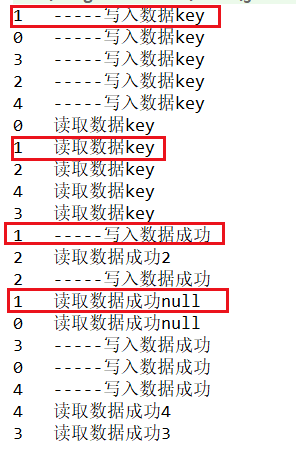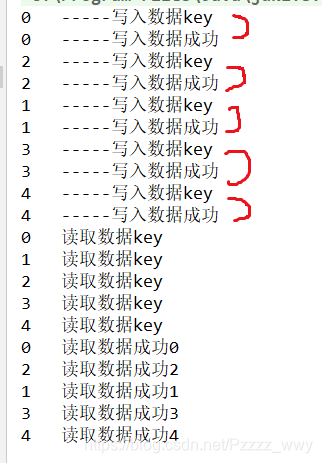这次讲解的数JUC的ReadWriteLock(读写锁):
多个线程同时读一个资源类没有任何问题,所以为了满足并发量,读取共享资源应该可以同时进行。 但是,如果有一个线程想去共享资源类,就不应该再有其他线程可以对该资源进行读或写。
- 总结:读读共存 读写不共存 写写不共存
接下来先看个案例:
代码如下:
public class ReadWriteLockDemo {
public static void main(String[] args) {
MyCache myCache = new MyCache();
for (int i = 0; i < 5; i++) {
final int finali= i;
new Thread(() -> {
try {
myCache.put(finali+"", finali+"");
} catch (InterruptedException e) {
e.printStackTrace();
}
}, String.valueOf(i)).start();
}
for (int i = 0; i < 5; i++) {
final int finali= i;
new Thread(() -> {
try {
myCache.get(finali+"");
} catch (InterruptedException e) {
e.printStackTrace();
}
}, String.valueOf(i)).start();
}
}
}
class MyCache {
private volatile Map<String, Object> map = new HashMap<>();
public void put(String key, Object value) throws InterruptedException {
System.out.println(Thread.currentThread().getName() + "\t-----写入数据key");
Thread.sleep(3000);
map.put(key, value);
System.out.println(Thread.currentThread().getName() + "\t-----写入数据成功");
}
public void get(String key) throws InterruptedException {
System.out.println(Thread.currentThread().getName() + "\t读取数据key");
Thread.sleep(3000);
Object result = map.get(key);
System.out.println(Thread.currentThread().getName() + "\t读取数据成功" + result);
}
}
运行结果如下:

我们可以看到的是在1进行写入数据的时候,此时还没有写入成功,就已经对1进行了读取操作,就像我们数据库的原子性一样,这里在还没有对数据进行写入完成就进行了读取的操作,所以读取的为空。
接下来我们看看加入了读写锁的效果:
代码如下 :
这里只需要对MyCache进行修改:
class MyCache {
private volatile Map<String, Object> map = new HashMap<>();
private ReadWriteLock readWriteLock = new ReentrantReadWriteLock();
public void put(String key, Object value) throws InterruptedException {
readWriteLock.writeLock().lock(); //上写锁
try {
System.out.println(Thread.currentThread().getName() + "\t-----写入数据key");
Thread.sleep(3000);
map.put(key, value);
System.out.println(Thread.currentThread().getName() + "\t-----写入数据成功");
} catch (Exception e) {
e.printStackTrace();
} finally {
readWriteLock.writeLock().unlock();
}
}
public void get(String key) throws InterruptedException {
readWriteLock.readLock().lock(); //上读锁
try {
System.out.println(Thread.currentThread().getName() + "\t读取数据key");
Thread.sleep(3000);
Object result = map.get(key);
System.out.println(Thread.currentThread().getName() + "\t读取数据成功" + result);
} catch (Exception e) {
e.printStackTrace();
} finally {
readWriteLock.readLock().unlock();
}
}
}
运行结果如下:

可以看到我们对写保持了一致性,读保证了可并发读,防止了在写的时候进行了读的操作,所以这就是读写锁的作用 。
总结:读读共存 读写不共存 写写不共存